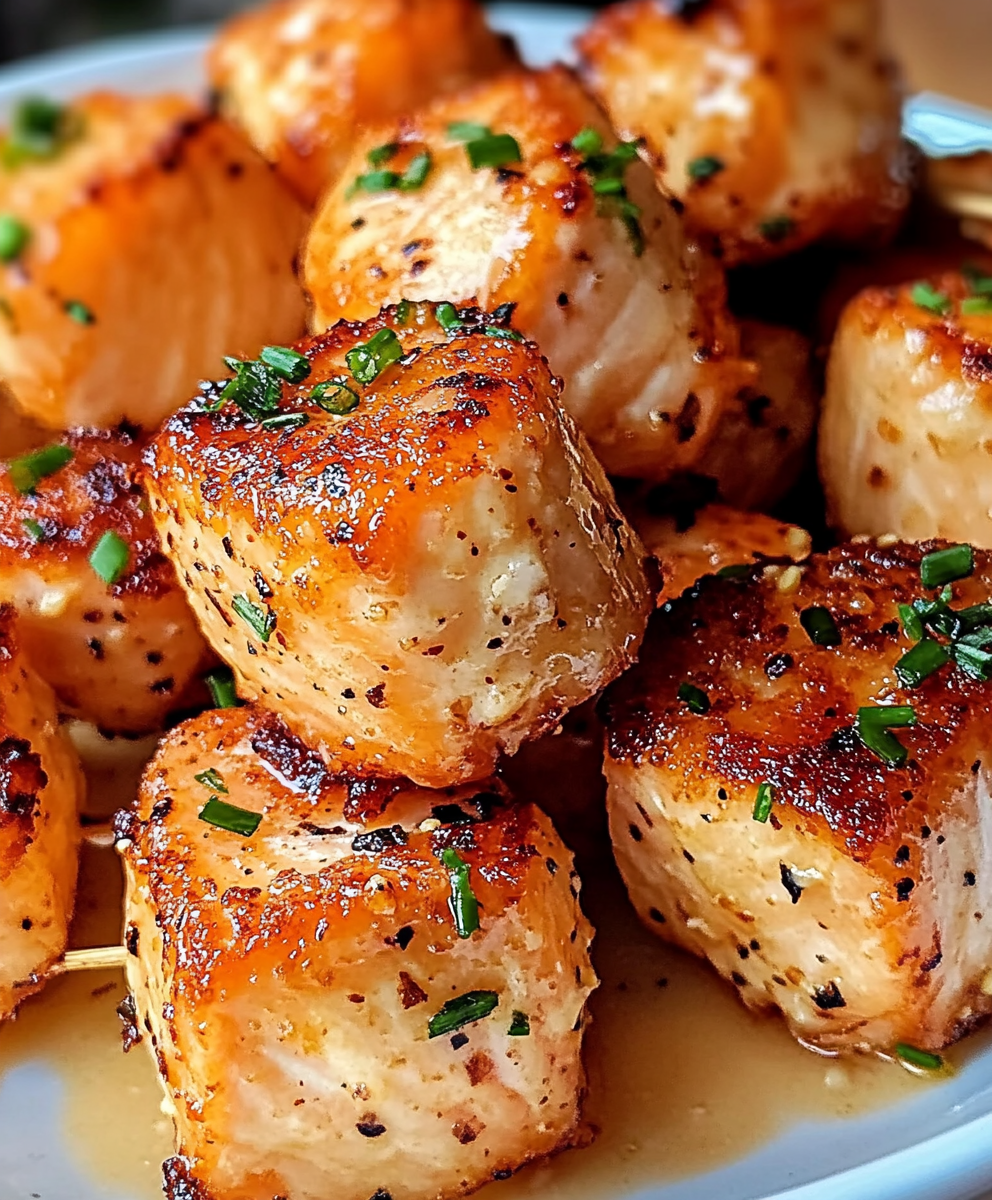Slowly Braised Beef Short Rib Ragu

Fall-apart beef short ribs slowly braised with soffritto, tomatoes, herbs, and red wine, finished with cream and parmesan—perfect tossed with pappardelle, polenta, or gnocchi.
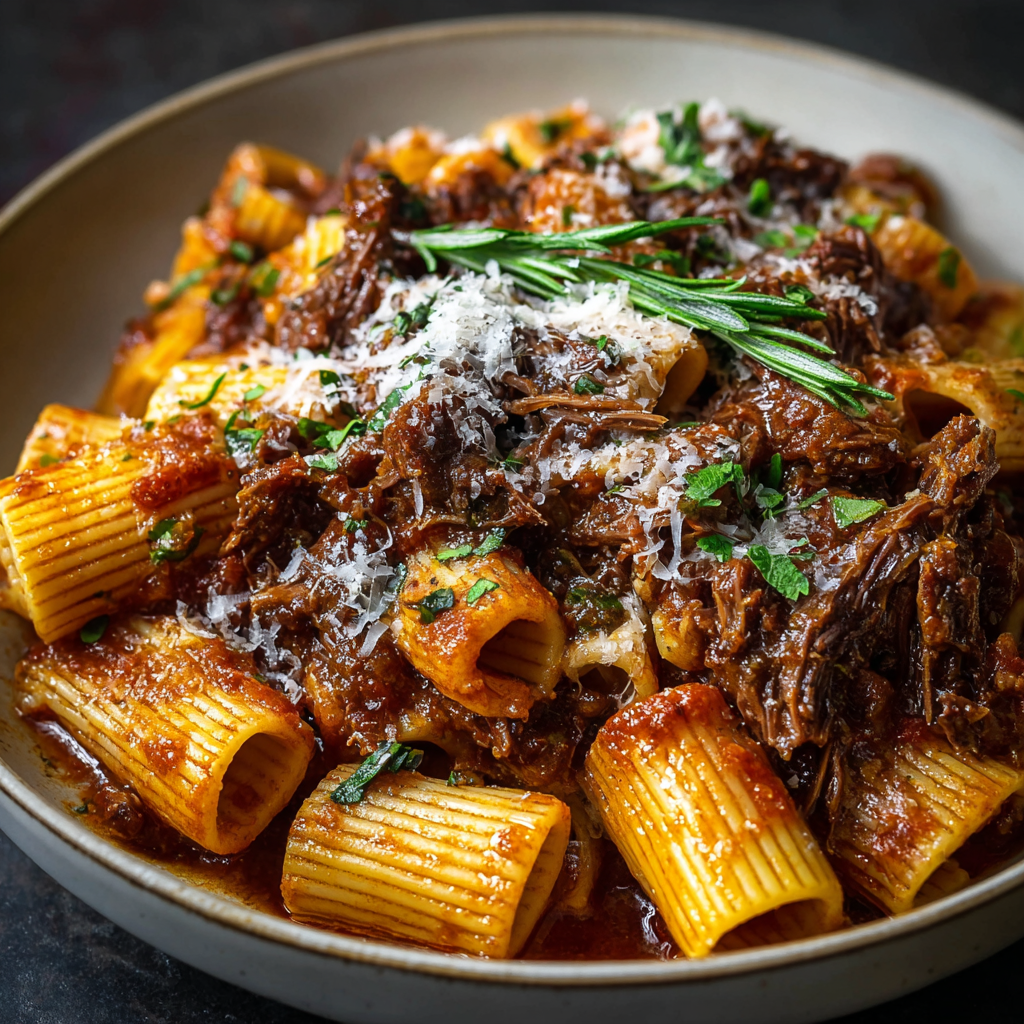
This slowly braised beef short rib ragu has been a centerpiece at many of my family gatherings — the kind of dish that fills the house with rich, savory aromas and makes everyone linger at the table. I discovered this combination while adapting a classic Italian braise for a holiday dinner when I wanted something that felt luxurious yet comforting. The short ribs slowly collapse into tender ribbons that mingle with concentrated tomato, red wine, and deeply caramelized vegetables, producing a sauce that’s both bold and silky.
What makes this preparation special is the time put into building layers of flavor: generous browning of the meat, a long, patient browning of the soffritto (carrots, onion, and celery), a quick caramelization of tomato paste, and then a slow, steady braise until the meat practically falls apart. I first served it to friends on a rainy evening and watched them trade forks and stories until the last plate was scraped clean. It’s the sort of dish worth the three-hour simmer because the payoff is melt-in-your-mouth beef and a sauce so complex you’ll want to savor every bite.
Why You'll Love This Recipe
- Deep, layered flavor built by browning the short ribs, slowly caramelizing the soffritto, and concentrating tomato paste for a robust, well-rounded sauce.
- Feeds a crowd easily—this version yields 10–12 servings, making it perfect for dinner parties or holiday gatherings with minimal hands-on time.
- Flexible finish: toss with pappardelle, spoon over creamy polenta, or pair with gnocchi for different textures and presentations.
- Make-ahead friendly: the sauce improves in the fridge for 24–48 hours and freezes beautifully for up to 3 months, saving you time on busy nights.
- Accessible ingredients: uses pantry staples and simple herbs; quality short ribs and a good dry red wine make a noticeable difference.
I’ve learned to trust slow cooking for this dish — the first time I let the ragu rest overnight I was stunned by how the flavors married. Family members who rarely reach for seconds stayed for thirds, and the leftovers the next day were even better. It’s become my go-to when I want to feed a group with something that feels indulgent but is actually very straightforward to prepare.
Ingredients
- Beef short ribs (4 lb): English-cut short ribs with good marbling give the richest flavor and texture; look for consistent meat-to-bone ratio and choose USDA choice or higher when possible.
- Olive oil (3 Tbsp): Use a neutral extra-virgin or light olive oil to brown meat without smoking; reserve 2 Tbsp worth of fat in the pot for flavor.
- Soffritto — carrots, yellow onion, celery: 3 large carrots, 1 large yellow onion, 1 stalk celery, all finely diced; slow browning of these aromatics is essential for a deep base.
- Garlic (8 cloves): Finely chopped or grated so it integrates into the sauce; adds a fragrant top note late in the soffritto stage.
- Tomato paste (6 oz): Cooked until deeply browned to add umami and sweetness; use a good-quality paste for best results.
- Dry red wine (1 cup): Use a medium-bodied wine such as Chianti, Merlot, or Cabernet; it adds acidity and depth—cooking removes most alcohol.
- Herb bundle: Fresh poultry herb blend packet (0.75 oz) or a tied bundle of rosemary, sage, and thyme plus 2 bay leaves for aromatic complexity.
- Parmesan rind (optional): Adds savory depth—keep from a wedge and toss in while braising for extra umami.
- Crushed tomatoes (14 oz): Canned crushed tomatoes provide body—San Marzano-style or quality crushed tomatoes are recommended.
- Beef stock (2 cups): Low-sodium stock or water to braise; adjust salt at the end to taste.
- Salt & pepper: Kosher salt for seasoning and coarse black pepper to taste during browning and after braising.
- Pasta & finishing: 24 oz pappardelle (or casarecce, bucatini, or gnocchi), 1/2 cup heavy cream, and 1/2 cup grated parmesan; additional grated parmesan and chopped herbs for serving.
Instructions
Brown the short ribs: Pat the short ribs dry with paper towels and generously season with 1 heaping tablespoon kosher salt and freshly ground black pepper. Heat 2–3 tablespoons olive oil in a 5‑quart Dutch oven over medium‑high until shimmering. Brown ribs in batches 3–4 minutes per side until deeply caramelized. Transfer to a plate. Drain off all but 2 tablespoons of fat. Brown the soffritto: Add the diced carrots, onion, and celery to the pot with 1 teaspoon kosher salt. Reduce heat to medium and cook, stirring occasionally, until the vegetables are deeply browned and sweet, about 15–20 minutes. This slow browning builds the sauce’s base—don’t rush it. Add aromatics and tomato paste: Stir in the garlic and cook 1–2 minutes until fragrant. Add the tomato paste and cook, stirring often, until it darkens and begins to stick slightly, 2–3 minutes—this concentrates flavor and adds caramelized notes. Deglaze with red wine: Increase heat to medium‑high and pour in 1 cup red wine. Scrape up browned bits from the bottom with a wooden spoon. Cook until the wine is mostly reduced, 3–4 minutes—this intensifies acidity and layers the flavors. Build and simmer: Tie the herb bundle with kitchen twine (or chop if no twine) and add to the pot with 2 bay leaves and the parmesan rind, if using. Add crushed tomatoes, 2 cups beef stock, and the browned short ribs. Bring to a boil, then reduce to low, cover, and simmer gently for 2½–3 hours, until the ribs are fall‑apart tender. Add a splash of water if it reduces too quickly. Shred and finish the sauce: Remove the ribs to a cutting board and discard herbs, bay leaves, and parmesan rind. Shred meat with forks, discarding bones. Return shredded beef to the pot and simmer gently. At serving time stir in 1/2 cup heavy cream and 1/2 cup grated parmesan and adjust seasoning with salt and pepper. Cook the pasta and combine: Cook 24 oz pappardelle in a large pot of salted boiling water until al dente. Reserve about 1 cup pasta water before draining. Add pasta to the sauce, tossing over medium heat 1–2 minutes so pasta absorbs sauce; loosen with reserved water if needed and add extra parmesan to tighten as desired. Serve: Portion into bowls, top with additional grated parmesan, chopped parsley or basil, and crushed red pepper if you like heat. Serve immediately with a glass of the same red wine you cooked with.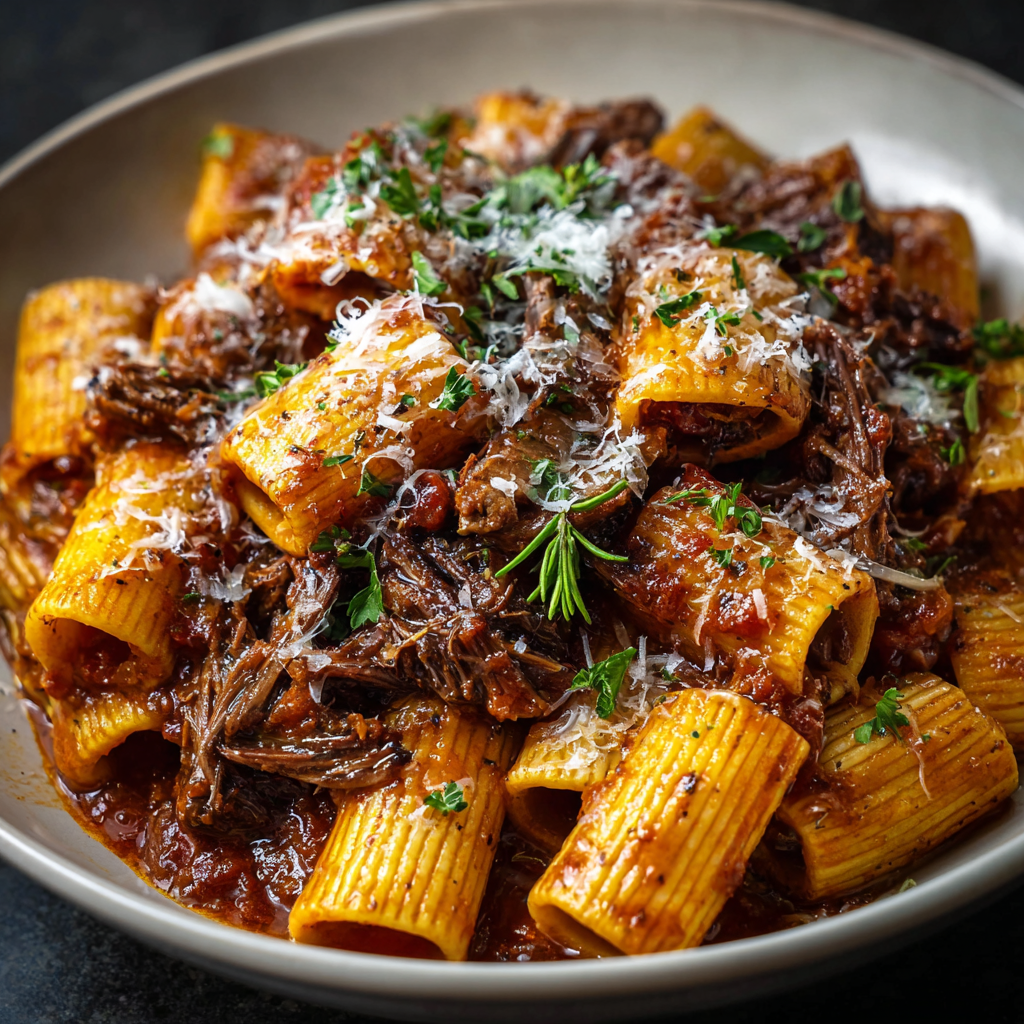
You Must Know
- This dish is high in protein and fat—rich and filling; plan for smaller portions if serving many courses or lighter sides.
- Refrigerate leftovers in an airtight container for 4–5 days; freeze in portioned containers up to 3 months for best quality.
- Use low‑sodium stock to control salt levels; adjust final seasoning after braising since flavors concentrate during reduction.
- Alcohol cooks down during braising but adds important acidity—substitute with extra stock plus a tablespoon balsamic if avoiding wine.
My favorite thing about this preparation is how forgiving it is: if the sauce reduces too quickly, add stock; if it seems thin after cooling, reheat and simmer to tighten. The family always fights over the pieces with the most caramelized edges, and I keep a small stash for myself the next day — the leftovers are pure gold with a fried egg on top.
Storage Tips
To store, cool the ragu to room temperature (no longer than two hours), then refrigerate in an airtight container for 4–5 days. For longer storage, portion into freezer-safe containers and freeze for up to 3 months. Thaw in the refrigerator overnight, then reheat gently on the stove, adding a splash of stock to loosen as needed. For reheating from frozen, submerge the sealed container in cold water to speed thawing, or reheat directly in a covered saucepan, starting low and gradually raising the heat to avoid scorching.
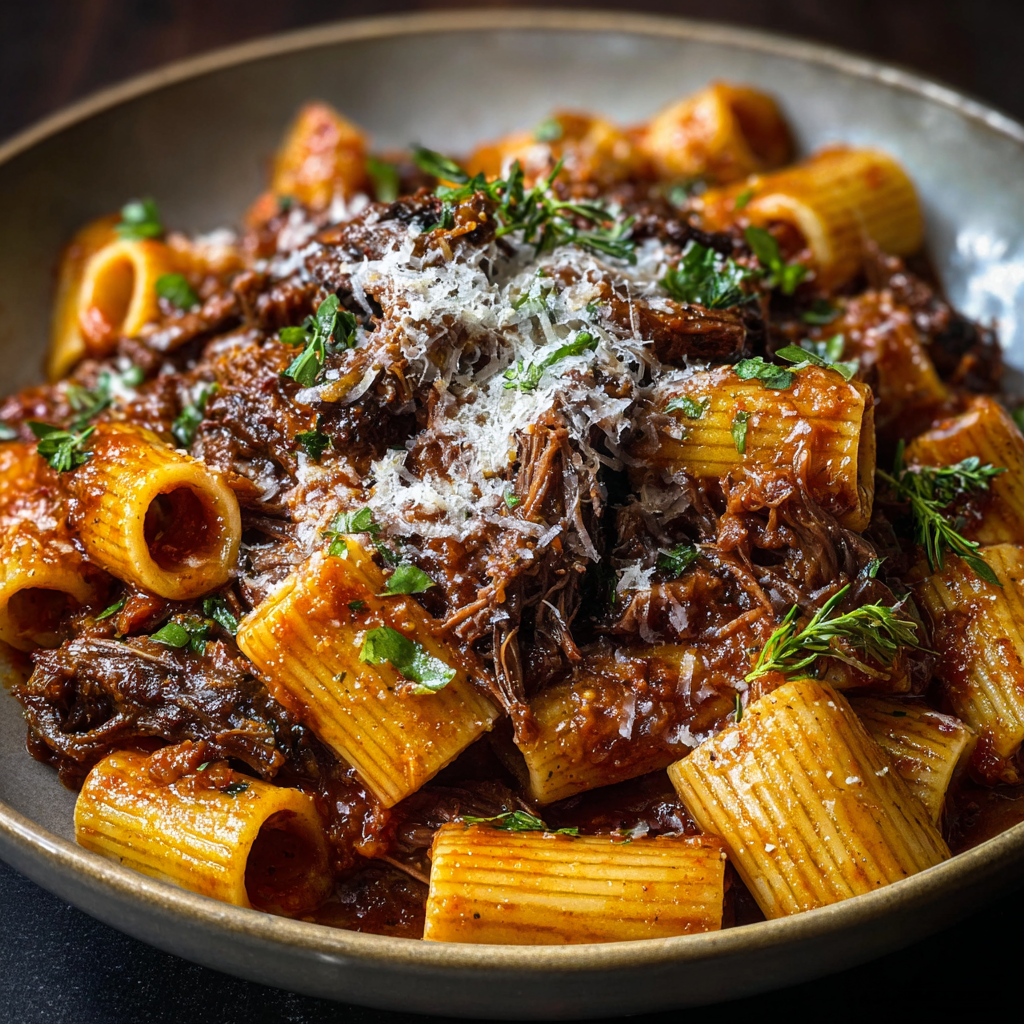
Ingredient Substitutions
If short ribs are unavailable, use beef chuck roast cut into large pieces (about 4 lb) and adjust braise time to achieve fall‑apart tenderness (2–2½ hours). For a lighter final sauce, omit the heavy cream and finish with 2–3 tablespoons of butter for gloss. To make the sauce dairy-free, skip the parmesan rind and cheese and finish with extra olive oil and a pinch of nutritional yeast for umami. If avoiding wine, substitute an equal volume of beef stock plus 1 tablespoon balsamic vinegar to mimic acidity.
Serving Suggestions
Traditionally tossed with wide pappardelle, this ragu also shines over creamy polenta, buttery mashed potatoes, or potato gnocchi. For a lighter plate, serve a small portion of ragu alongside roasted vegetables and a crisp green salad. Garnish with grated parmesan, chopped parsley, or a drizzle of high‑quality extra‑virgin olive oil. Pair with medium-bodied red wines like Chianti or Barbera that have enough acidity to cut through the richness.
Cultural Background
This style of braised beef ragu has roots in northern and central Italy where slow braises traditionally transform tougher cuts into celebrated dishes. The technique of browning meat, slowly caramelizing aromatics, and braising in wine and tomatoes is classic Italian comfort cooking. While ragù alla bolognese typically uses minced meat, this short rib approach uses whole cuts for a chunkier, meat-forward experience that echoes regional braises and modern interpretations served with wide pasta.
Seasonal Adaptations
In winter, serve the ragu with hearty sides like polenta or root-vegetable mash and warm spices in the salad vinaigrette. For spring and summer, use fresher herbs, lighten the sauce with less cream, and serve alongside a crisp arugula salad. Holiday variations can include finishing the sauce with a tablespoon of truffle oil or stirring in roasted mushrooms for extra earthiness.
Meal Prep Tips
Make the ragu two days ahead for best flavor: refrigerate overnight and skim any solidified fat for a cleaner sauce before reheating. Portion into single‑serve containers for easy lunches or weeknight dinners. When reheating, bring the sauce up to a gentle simmer, add reserved pasta water, and toss with freshly cooked pasta for the best texture. Label frozen containers with date and portion size to rotate stock easily.
Ultimately, this slowly braised short rib ragu rewards patience with a depth of flavor that becomes the heart of any meal. Invite friends over, pour a glass of the same red wine you cooked with, and enjoy the comfort of a dish made to be shared.
Pro Tips
Pat the short ribs very dry before seasoning to ensure a deep brown crust during searing.
Slowly caramelize the soffritto—rushing this step loses foundational flavor.
Reserve pasta cooking water to adjust sauce consistency when tossing with pasta.
Chill and skim fat after refrigeration if you want a leaner final sauce before reheating.
This nourishing slowly braised beef short rib ragu recipe is sure to be a staple in your kitchen. Enjoy every moist, high protein slice — it is perfect for breakfast or as a wholesome snack any time.
FAQs about Recipes
Can I freeze the ragu?
Yes—freeze cooled ragu in airtight containers up to 3 months. Thaw overnight in the refrigerator before reheating.
What kind of wine should I use?
Use any medium-bodied dry red wine such as Chianti, Merlot, or Cabernet. The wine adds acidity and depth; cooking removes most alcohol.
Tags
Slowly Braised Beef Short Rib Ragu
This Slowly Braised Beef Short Rib Ragu recipe makes perfectly juicy, tender, and flavorful steak every time! Serve with potatoes and a side salad for an unforgettable dinner in under 30 minutes.

Ingredients
Meat
Vegetables & Aromatics
Liquids & Tomatoes
Herbs & Extras
Pasta & Finishing
Instructions
Brown the short ribs
Pat short ribs dry, season generously, and brown in batches in a heavy Dutch oven over medium-high heat, 3–4 minutes per side. Reserve 2 Tbsp fat in the pot.
Brown the soffritto
Add diced carrots, onion, and celery to the pot with 1 tsp salt and cook until deeply browned, 15–20 minutes, stirring occasionally to avoid burning.
Add aromatics and tomato paste
Stir in garlic for 1–2 minutes, then add tomato paste and cook until it darkens, 2–3 minutes, stirring constantly to develop flavor.
Deglaze with wine
Increase heat and add 1 cup red wine, scraping up browned bits. Reduce until nearly absorbed, about 3–4 minutes, concentrating the sauce.
Build and simmer
Add herb bundle, bay leaves, parmesan rind, crushed tomatoes, and 2 cups beef stock. Return short ribs to pot, bring to a boil, then cover and simmer gently 2½–3 hours.
Shred and finish
Remove ribs, discard herbs and rind, shred meat off bones, return meat to sauce, stir in 1/2 cup heavy cream and 1/2 cup parmesan, and adjust seasoning.
Cook pasta and combine
Cook pasta to al dente in salted water, reserve 1 cup pasta water, drain, then toss pasta with the sauce over medium heat, loosening with reserved water as needed.
Serve
Plate the pasta with ragu, top with extra grated parmesan and chopped fresh herbs, and serve immediately with optional crushed red pepper.
Last Step: Please leave a rating and comment letting us know how you liked this recipe! This helps our business to thrive and continue providing free, high-quality recipes for you.
Nutrition
Did You Make This?
Leave a comment & rating below or tag
@kitchenfunwithmy3sons on social media!

Categories:
You might also like...
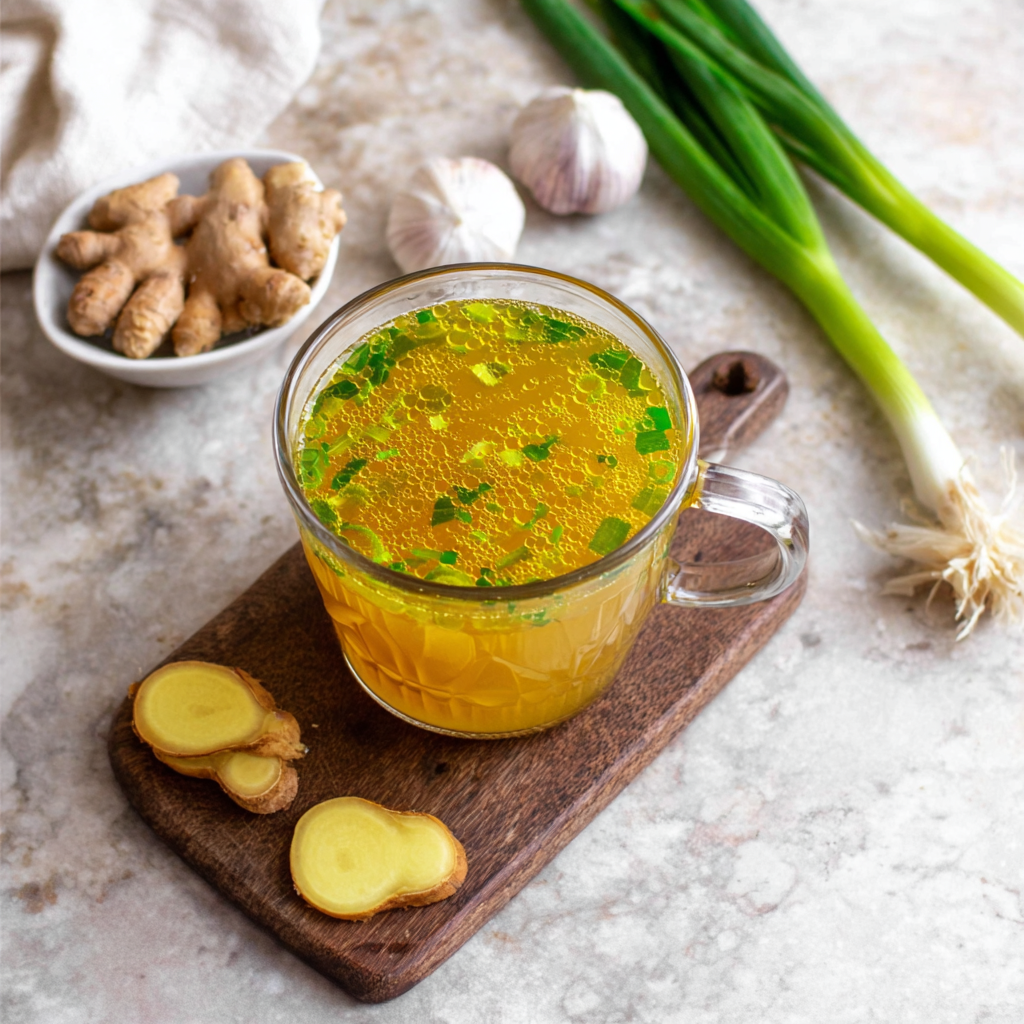
10 Minute Immune Boosting Broth
A fast, nourishing broth packed with garlic, ginger, miso, and turmeric to support immunity. Ready in 10 minutes and naturally dairy free, gluten free, and vegan.

20-Minute Greek Pasta Salad
A bright, quick Greek-style pasta salad loaded with crunchy vegetables, Kalamata olives, tangy feta, and a creamy tzatziki dressing—ready in 20 minutes and perfect for summer gatherings.
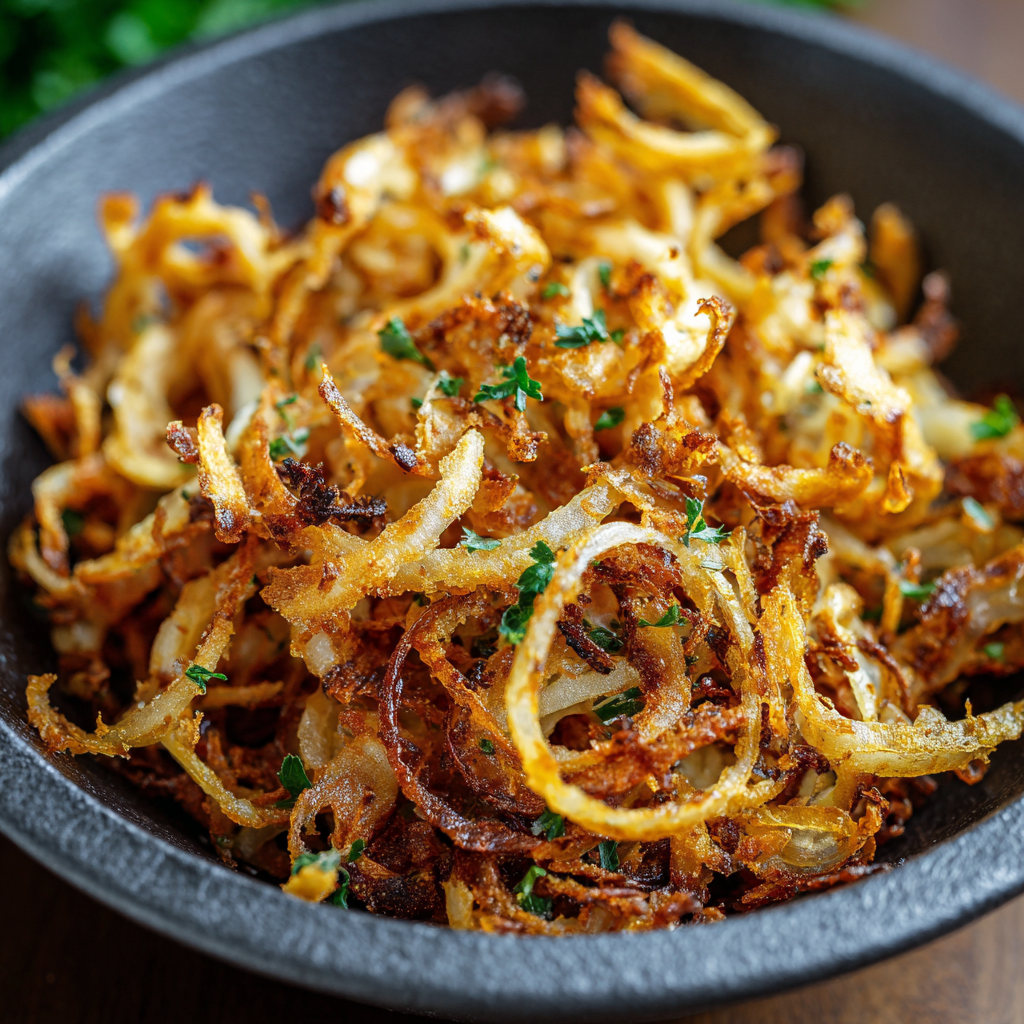
Air Fried Crispy Onion
Make perfectly caramelized crispy onions in an air fryer with just a touch of oil for a crunchy, savory topping that elevates any dish.

Did You Make This?
Leave a comment & rating below or tag @kitchenfunwithmysons on social media!
Rate This Recipe
Share This Recipe
Enjoyed this recipe? Share it with friends and family, and don't forget to leave a review!
Comments (1)
This recipe looks amazing! Can't wait to try it.
Comments are stored locally in your browser. Server comments are displayed alongside your local comments.
Hi, I'm Rachel!
What's Popular
Get My 30-Minute Meals email series!
Quick and easy dinner ideas delivered to your inbox.

